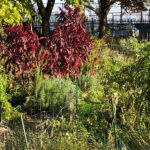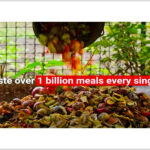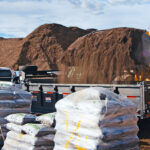Jessica Toth
BioCycle May/June 2019
In 2013, a millennial surfer came to the Solana Center for Environmental Innovation in Encinitas, California, to ask about bringing his food scraps to us. He explained that he lived in an apartment nearby and made a lot of pressed juice health drinks. He despaired of continuing to throw all the pulp and peels in the trash. Following this visit, he delivered his kitchen fruit and vegetable scraps each week to be composted on-site at the Solana Center. Soon, he corralled neighbors to collect their food scraps, which he brought to us as well. He eventually moved away, but had planted the seeds of an idea for community composting.
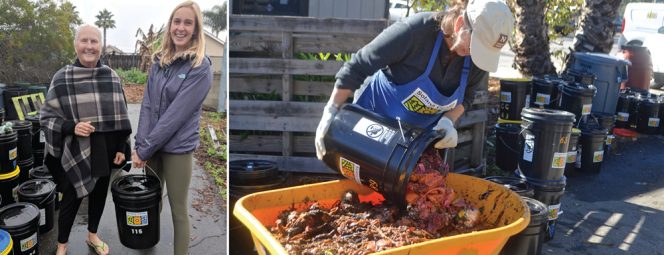
Participants drop their bokashi-treated food scraps at Solana Center (left) and receive a clean bucket — and some compost — to take home. When capacity in the composting bins is available, the buckets are emptied (right) and mixed with bulking agents.
Now, more than five years later, Solana Center has an on-site composting program for the next wave of early adopters. Known as Food Cycle, the program recently completed its first year, with more than 90 households, organizations, and regional events participating. Food Cycle grew from Solana Center’s expanding work on composting in the San Diego area. Solana Center gives basic residential composting workshops and advanced Master Composter courses. In addition, to address the growing interest in community-scale composting, education staff created a “mid-scale” composting demonstration and training center, as well as a course to train community gardeners, restaurateurs, farmers, and others about closed-loop, on-site “captive” composting, and broader ranging “community” ecosystems. However solutions for those who can’t or won’t compost food waste on their own were needed.
The San Diego region does not yet have commercial facilities available to process all the food waste generated. EDCO, a local hauler with extensive recycling operations, plans to open a large anaerobic digestion facility by the end of 2020. However, this site and others with planned completion further in the future will not have the capacity to handle all of the estimated more than 500,000 tons of food waste that the region generates annually. There will be an ongoing need for decentralized community-scale programs.
Program Details
Food Cycle was designed as a proof-of-concept program, accepting all types of food scraps — vegetative food waste, and all plate scrapings including meat, bones, dairy, and sauces — as well as food-soiled paper and paper towels. In addition, some compostable fiber-based serviceware (e.g., plates, bowls) from events have been shredded and composted. Figure 1 illustrates the steps.
Weekly drop-offs from households typically amount to a total of about 240 pounds. Organizations — businesses, the local City Hall, and a community center — contribute lunch scraps, with each drop ranging from 75 to 180 pounds approximately every 6 weeks. Households typically keep one bucket; organizations keep multiple buckets. In addition, event organizers can contract to have Solana Center handle their food waste. Events have generated from 56 pounds at a breakfast for 200 people to 780 pounds from a beach concert and surf contest attended by 17,000.
The “Food Cycle Flow” graphic (below) illustrates the five stages of the Food Cycle program. Steps include:
- Collection: Participants collect food scraps in 5-gallon buckets with an airtight lid. After adding material to the bucket, participants sprinkle bokashi-inoculated bran over the food and secure the lid. Once their buckets are full, they bring them to Solana Center.
- Drop-Off: Participants leave their full buckets and take back clean and empty buckets. Each filled bucket is tagged with the date of delivery and then sits for a minimum of three weeks to allow the microbes in the bokashi to ferment the food scraps in an anaerobic environment.
- Pile Building: When composting capacity is available, e.g., after emptying a covered aerated static pile (ASP) bin, 15 to 20 staff and volunteers create a mix of feedstock, including mulch, paper towels, coffee grinds, and juice pulp in addition to the bokashi-processed food scraps. Approximately 50 5-gallon buckets of food waste are incorporated. The entire process, including bucket cleaning, takes the crew half a day.
- Composting and Curing: The ASP is monitored regularly to ensure it reaches temperatures of 131°F for a minimum of three days and is well oxygenated. The composting process typically takes six weeks. The compost then cures for at least 6 to 8 weeks.
- Compost Distribution: Finished compost is sifted and given to program participants.
Using bokashi preprocessing and airtight containers allays concerns about vectors and odors. Benefits include: Inclusion of postconsumer food scrap; Storage at point of generation until participants are ready to transport to Solana Center; Containment of the “ick factor” of storing and transporting food waste; and Ability to stockpile material at Solana Center until a new ASP is ready to be built. The Center has used bokashi to preprocess a variety of organic materials, including soda, candy, and whole rodent carcasses.
Site Enhancements
Food Cycle began with a series of three residential static composting bins. The effort to turn the material regularly became untenable as the quantity of food scraps increased. A two-bin ASP system was created, with both 1.6 cubic yard (cy) boxes supported by one blower motor (one-quarter horsepower, 110 volt, 2 amp) to aerate the piles. With each new pile built, the blower starts with a cycle of 30 seconds on and 30 minutes off; then the frequency is adjusted to modulate the pile’s temperature. With further growth of the program, one of the 1.4-cy boxes was converted to a 4.75-cy hexagon. A second 4.75-cy hexagon is being constructed and will be serviced by the same motor. Designs for the ASPs were purchased from O2Compost. ReoTemp donated a thermometer and an OxyTemp, for measuring oxygen levels.
Another recent enhancement is a bucket-cleaning table. On average, it has been taking more than four minutes to clean out an emptied bucket by hand using scrub brushes and a vinegar solution. The bucket-cleaning table, designed and built by a volunteer, uses high pressure sprinkler heads mounted on a waist-high counter. It is expected to cut the bucket-cleaning time by half.
Solana Center does not offer pick-up service due to staffing availability and added cost. This has limited participation to only the most motivated early adopters. To reach the early majority market, a commercial operation would need to include pick-up service. There has been minimal contamination from nonorganic materials in the buckets. This is attributed to the motivated participants who are willing to expend cost and effort to be part of a solution.
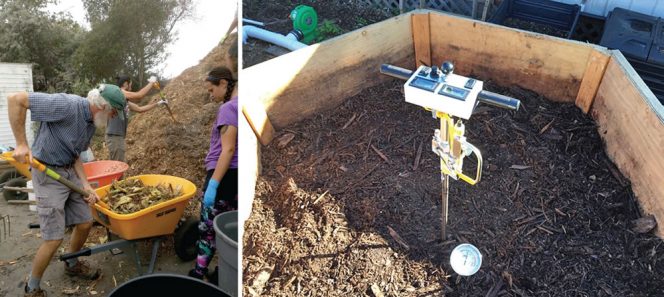
Staff and volunteers manage the aerated static pile composting process — from adding fresh material on the front end (top) to sifting compost on the back end. Piles are monitored using a Reotemp thermometer and oxygen meter.
One program participant (City Hall) is experimenting with lining its kitchen caddies with compostable bags. The bags are put in the 5-gallon buckets and bokashi bran is sprinkled on before sealing the lid. (The compostable liners do not appear to break down in the bucket.) No compostable bioplastic utensils are allowed. Food Cycle is not able to take food scraps from food-generating businesses because, on a consistent basis, the amount of material would overwhelm the system. Even small restaurants are discarding 500 to 700 pounds per week.
Food Cycle does not currently sustain itself with participant fees. To supplement, Solana Center relies on financial contributions from Beyster Family Foundations, the Cities of Encinitas and Del Mar, and EDCO Disposal.
Motivation
Food Cycle is growing due to increased awareness in the region about the environmental issues associated with landfilling organic material. By demonstrating a solution, Solana Center aims to encourage the community dialog about food waste. A recurring comment from participants is, “ I didn’t believe that I had much food waste until I joined the Food Cycle program. Now my trash is almost empty each week.”
The most prevalent reason given for joining Food Cycle is a sense of environmental stewardship. Representatives from organizations and events are further interested in demonstrating environmental leadership. And some convey that they feel it is rewarding to be part of a solution that closes the loop from solid waste to beneficial soil nutrient.
With residents, an additional draw to Food Cycle is the cooperative environment, in which they help with the physical activities, such as building the compost pile and harvesting the finished compost, in exchange for taking home a share of the compost. The combination of community involvement, cooperative action, and environmental stewardship draws these early adopters and lays the groundwork for the next iteration of the program into the larger community. The millennial surfer who first came to Solana Center over five years ago would be proud to see how the seeds planted for a community-wide food waste diversion program have sprouted.
Jessica Toth is the Executive Director of 35-year-old Solana Center for Environmental Innovation, located in Encinitas, California. Solana Center is a dynamic organization, fostering environmental change through education, outreach, and consulting services.



